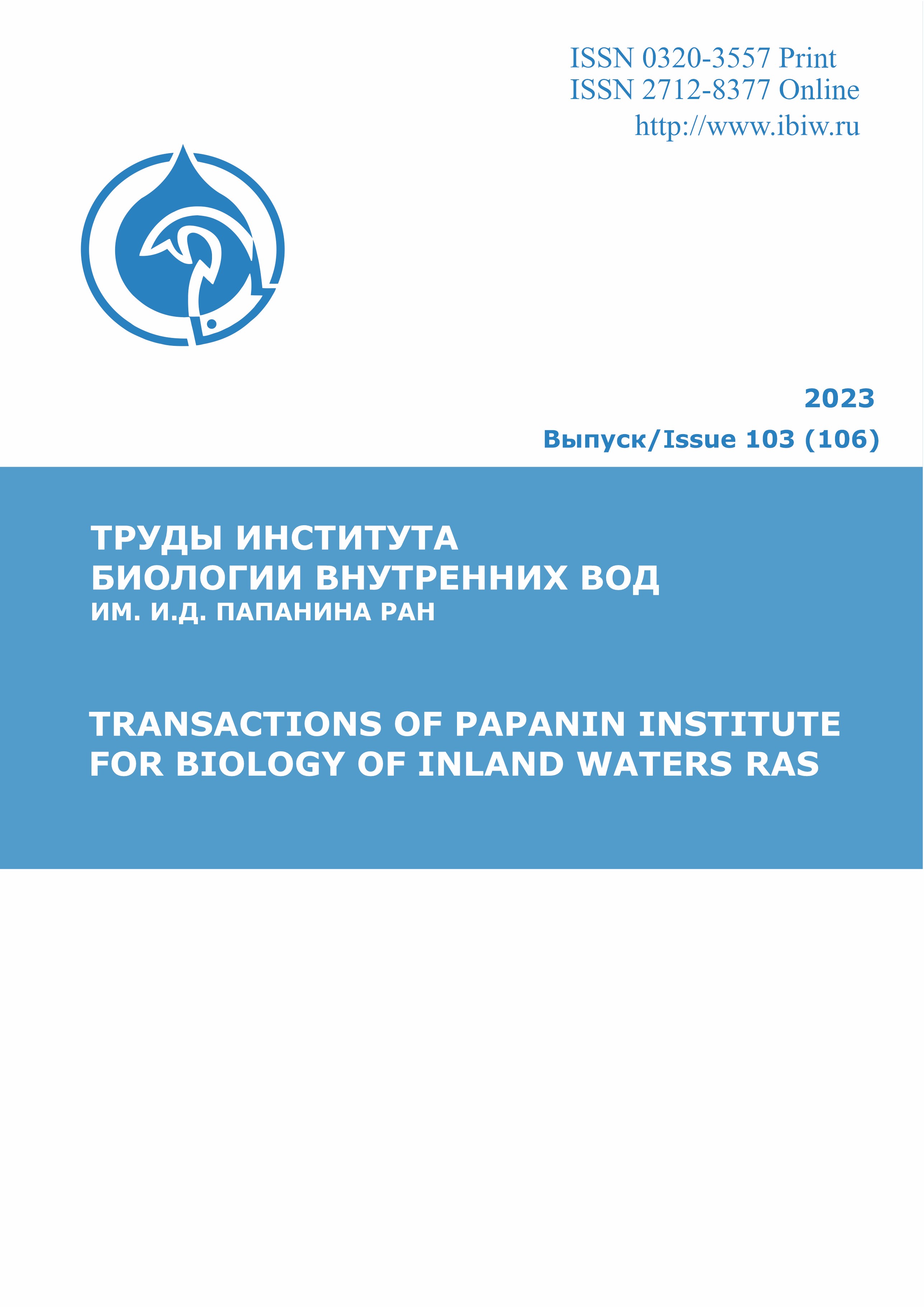УДК 595.324 Cladocera. Ветвистоусые
Обобщены сведения о видовом составе и распространении микопаразитов зоопланктона: 8 видов Chytridiomycota, 2 – Ascomycota, 7 – микроспоридии, 19 – грибоподобных организмов Oomycota. Приведены известные жизненные циклы, зависимость распространения инфекций от температуры воды, плотности популяций хозяина и паразита, возраста хозяина. Указано наличие сапротрофных видов в планктоне. Они питаются мертвыми обитателями планктона и привнесенными трупами беспозвоночных из наземных условий: 30 видов Chytridiales, 4 – Mucorales и 35 видов грибоподобных Saprolegniales. Приведены сведения о роли грибов в питании зоопланктона, в основном это зооспоры и митоспоровые аскомицеты.
микопаразиты, сапротрофы, инфицирование, питание зоопланктона
1. Бравина И.В. Микофлора комаров мелководных зон Рыбинского водохранилища и дельты Волги // Микология и фитопатология. 1987. Т. 21, Вып. 1. С. 8-13.
2. Герасимов Ю.В., Малин М.И., Борисенко Э.С., Жданова С.М., Цветков А.И., Смирнов А.К. Пищевое поведение и питание ряпушки (Coregonus albula) в озере Плещеево в период температурной стратификации // Озера Евразии: проблемы и пути их решения. Материалы II Международной конференции. Казань: Академия наук республики Татарстан, 2019. С. 234-239.
3. Голубева О.Г. Chytridiomycetes. Вып. 1. Пор. Chytridiales. СПб.: Мир и семья, 1995. 168 с.
4. Коваль Э.З. Определитель энтомофильных грибов СССР. Киев: Наукова думка, 1974. 260 с.
5. Пыстина К.А. Род Pythium Pringsh. Определитель грибов России: Класс Оомицеты. Вып. 2. СПб.: Наука, 1998. 126 с.
6. Соколова Ю.Я. Происхождение микроспоридий и их положение в системе эукариот // Микология и фитопатология. 2009. Т. 43, Вып. 3. С. 177-192.
7. Batko A. Zarys hydromikologii. Warszawa: PWN, 1975.478 p.
8. Calabon M.S., Hyde K.D., Jones E.B.G., Bao D.F., Bhunjun C.S., Phukhamsakda C., Shen H.W., Gentekaki E., Al Sharie A.H., Barros J., Chandrasiri K.S.U., Hu D.M., Hurdeal V.G., Rossi W., Valle L.G., Zhang H., Figueroa M., Raja H.A., Seena S., Song H.Y., Dong W., El-Elimat T., Leonardi M., Li Y., Li Y.J., Luo Z.L., Ritter C.D., Strongman D.B., Wei M.J., Balasuriya A. Freshwater Fungal Biology // Mycosphere. 2023. Vol. 14. № 1. P. 195-413. DOI:https://doi.org/10.5943/mycosphere/14/1.
9. Calabon M.S., Hyde K.D., Jones E.B.G., Chandrasiri S., Dong W., Fryar S.C., Yang J., Luo Z.,L., Lu Y.Z., Bao D.F., Boonmee S. www.freshwaterfungi.org, an online platform for the taxonomic classification of freshwater fungi // Asian Journal of Mycology. 2020. Vol. 3. № 1. P. 419-445. DOI:https://doi.org/10.5943/ajom/3/1/14.
10. Czeczuga B., Czeczuga-Semeniuk E., Semeniuk-Grell A. Ecological diversity and economical importance of species from Aphanomyces genus // Afr. J. Agric. Res. 2016. Vol. 10 (48). P. 4356-4363. DOI:https://doi.org/10.5897/AJAR2015.9136.
11. Dallas T. Biotic and abiotic factors influencing hostpathogen dynamics in a zooplankton-fungus system. Athenes; Georgia: University of Georgia, 2016. 189 р.
12. Ebert D. Ecology, Epidemiology, and Evolution of Parasitism in Daphnia [Internet]. Bethesda (MD): National Library of Medicine (US), National Center for Biotechnology Information. 2005. Available from: http://www.ncbi.nlm.nih.gov/entrez/query.fcgi?db=Books
13. Garcia R.D., Jara F.G, Steciow M.M., Reissing M. Oomycete parasites in freshwater copepods of Patagonia: effects on survival and recruitment // Dis. Aquat. Org. 2018. Vol. 129. P. 128-134.
14. Garcia R.D., Jara F.G., Steciow M.M. Record of parasitic oomycetes on neotropical copepods in aquatic environments of Northwestern Patagonia (Argentina) // Acta Limnologica Brasilienses. 2020. Vol. 32. e16. DOI:https://doi.org/10.1590/S2179-975X0719.
15. Gleason F.H., Kagami M., Leferve E., Sime-Ngando T. The ecologyof chytrids in aquatic ecosystems: roles in food web dinamics // Fungal biology reviews. 2008. Vol. 22. № 1, P. 17-25. DOI:https://doi.org/10.1016/j.fbr.2008.02.001.
16. Gleason F.H., Marano A.V., Jonson P., Martin W.W. Blastocladian parasites of invertebrates// Fungal Biology Reviews. 2010. Vol. 24. № 1. P. 56-67. DOI:https://doi.org/10.1016/j.fbr.2010.03.004
17. Gleason F.H., Marano A.V., Lilje O., Lange L. What has happened to the ‘aquatic phycomycetes” (sensu Sparrow)? Part I: A brief historical perspective // Fungal Biology Reviews. 2017. Vol. 32. P. 26-33. DOI: 1016/j.fbr.2017.09.01.
18. Green J. Parasites and epibionts of Cladocera // Trans. Zool. Soc. London. 1974. Vol. 32. P. 417-515.
19. Hall S.R., Recker C.R., Duffy M.A., Cáceres C.E. Epidemic size determines population level effects of fungal parasites on Daphnia hosts // Oecologia. 2011. Vol. 166. P. 833-842. DOI:https://doi.org/10.1007/s00442-011-1905-4.
20. Johnson P.T.J., Stanton D.E., Preu E.R., Forshay K.J., Carpenter S.R. Dining on disease: how interactions between infection and environment affect predation risk // Ecology. 2006. Vol. 87. P. 1973-1980. DOI:https://doi.org/10.1890/0012-9658(2006)87[1973:DODHIB]2.0.CO;2.
21. Jonson P.T.J., Longcore J.E., Stanton D.E., Carnegie R.B., Shields J.D., Preu E.R. Chytrid infections of Daphnia pulicaria: development, ecology, pathology and phylogeny of Polycarium laeve // Freshwater Biology. 2006. Vol. 51. P. 634-648. DOI:https://doi.org/10.1111/j.1365-2427.2006.01517.x
22. Kagami M., von Elert E., Ibelings B.W., de Bruin A., Van Donk E. The parasitic chytrid, Zygorhizidium, facilitates the growth of the cladoceran zooplankters, Daphnia, in cultures of the inedible alga, Asteroinella // Proc. R. Soc. 2007. Vol. 274. P. 1561-1566. DOI:https://doi.org/10.1098/rspb.2007.0425.
23. Larson J.I.R., Ebert D., Várva J. Ultrastructural study of Glugea cladocera Pfeiffer, 1895, and transfer to the genus Agglomerata (Microspora, Dubosqiidae) // Europ. J. Protistol. 1996. Vol. 32. № 4. P. 412-422.
24. Lepère C., Domaizon I., Humbert J.-F., Jardillier L., Hugoni M., Debroas D. Diversity, spatial distribution and activity of fungi in freshwater ecosystems // Peer J. 2019. 7. e6247. DOI:https://doi.org/10.7717/peerj.6247.
25. Prόba D. Appearance of Sommerstorffia spinosa Arnaudov in Poland // Bull. Acad. Polon. Sci. C1. II. 1979. Vol. 27. № 8. P. 631-633.
26. Refardt D., Decaestecker E., Jonson P.T.J., Várva J. Morphology, molecular phylogeny, and ecology of Binucleata daphniae n.g., n.sp. (Fungi, Microsporidia), a parasite of Daphnia magna Straus, 1820 (Crustacea: Branchipoda) // J. Eucaryot. Microbiol. 2008. Vol. 55. № 5. P. 393. DOI:https://doi.org/10.1111/j.1550-7408.2008.00341.x.
27. Rocha J.R.S., Rocha F.P., Machado J.L. O gȇnero Myzocytopsis (Oomycota) no estado Piauί: novos regitros para o Brasil // Gala Scienta. 2017.Vol. 11. № 1. P. 98-115. DOI:https://doi.org/10.22478/ufpb.1981-1268.2017v11n1.34865.
28. Rosetti G. Fungal parasitism in freshwater calanojdpopulation: ecological consequences and possible mechanisms involvtd in the infection process// Hydrobiologia. 2005. Vol. 548. P. 167-176. DOI:https://doi.org/10.1007/s10750-005-4168-4
29. Scott W.W. A monograph of the genus Aphanomyces // Technical Bulletin. Virginia Agricultural experiment station. 1961. 95 p.
30. Sigee D.C. Freshwater microbiology. Biodiversity and dynamic interactions of microorganisms in the aquatic environment . Chichester: John Wiley et sons LTD, 2005. 524 p.
31. Sparrow F.K. Aquatic Phycomycetes. Ann Arbor: University of Michigan Press, 1960. 1188 p.
32. Thomas S.H., Housley J.M. The ecology and phylogeny of oomycete infections in Asplancha rotifers // Freshwater Biology. 2011. Vol. 56. № 2. P. 384-394. DOI:https://doi.org/10.1111/j.1365-2427.2010.02505.x.
33. Valois A.E., Bruns C.W. Parasites as prey: Daphnia reduse transmission of an oomycete broodparasite in the calanoid copepod Boeckella// J. Plankton Res. 2016. Vol. 38, № 5. P. 1281-1288. DOI:https://doi.org/10.1093/plankt/fbw055.
34. Voronin L.V. Terrigenous Micromycetes in Freshwater Ecosystems (Review) // Inland Water Biology. 2014. Vol. 7. № 4. P. 352-356. DOI:https://doi.org/10.1134/S1995082914040191.
35. Voronin L.V. Zoosporic fungi in freshwater ecosystems// Inland Water Biology. 2008. Vol. 1. № 4. P. 341-346. DOI:https://doi.org/10.1134/S1995082908040056.
36. Voronin L.V., Zhdanova S.M. Mycoparasite Infection of Daphnia cucullata Sars, 1862 (Crustacea, Cladocera, Daphniidae) in Lake Pleshcheyevo (Yaroslavl Oblast, Russia) // Inland Water Biology. 2021. Vol. 14, № 6. P. 792-796. DOI:https://doi.org/10.1134/S1995082921060146.
37. Whisler H.C., Zebold S.L., Shemanchuk J.A. Life history of Coelomomyces psorophorae// Proc. Nant. Acad. Sci U.S.A. 1975. Vol. 72. P. 693.
38. Wolinska J., Giessler S., Koerner H. Molecular identification and hidden diversity of novel Daphnia parasites from European lakes// Appl. Environ. Microbiol. 2009. Vol. 75. № 22. P. 7051-7059. DOI:https://doi.org/10.1128/AEM.01306-09
39. Wolska M., Mazurkiewicz-Zapałowicz K. Parasites of zooplankton and periphyton assemblages in the littoral zone of lakes in Drawa National Park, Poland // Acta Mycol. 2013. Vol. 48. №1. P. 51-59. DOI:https://doi.org/10.5586/am.2013.007
40. Wurzbacher C.M., Bӓrlocher F., Grossart H.-P. Fungi in lake ecosystems //Aquat Microb Ecol. 2010. Vol. 59. P. 125. DOI:https://doi.org/10.3354/ame01385.








